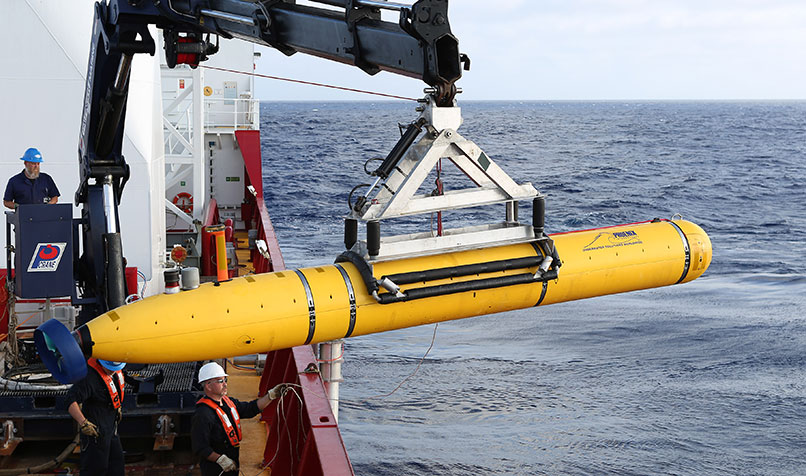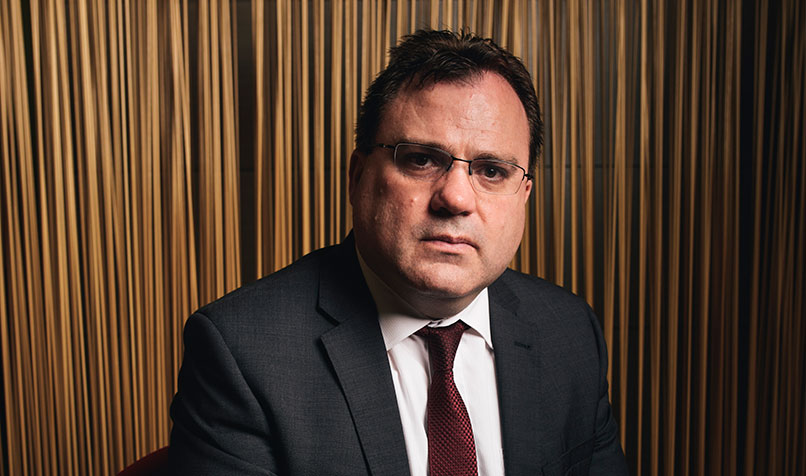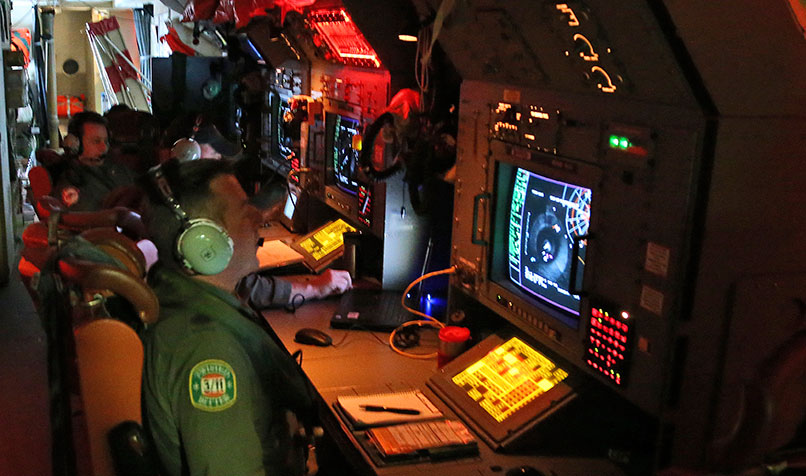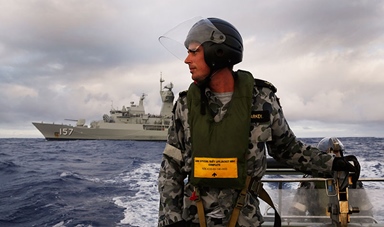Loading component...
At a glance
By Stephen Corby
For almost three years, Jason McGuire FCPA went to bed hoping he’d be woken by a call at 3am.
His phone was always on, never silenced, and every morning he would snatch it from his bedside table, praying someone had messaged to say they’d found a scrap of debris.
He wanted something, anything, that would bring to an end the emotional and exhausting search for the lost Malaysia Airlines flight MH370 and the 239 people who disappeared with it on 8 March 2014. Sadly, that phone call never came.
Epic Indian Ocean search
McGuire says his role as program governance and finance manager for the Australian Transport Safety Bureau’s (ATSB) search for flight MH370 was a lot more than just a job.
It’s the most difficult, and overwhelming, project he has ever been involved in, and has turned out to be the largest and most expensive search in aviation history, costing almost A$200 million.
“I tell people to imagine Tasmania, with all its mountains and valleys and terrain, and then you put, say, an average of 4000 metres of water on top of that, and that’s what we were dealing with, except that Tasmania is about 60,000 square kilometres, and the search area we had was double that,” the 45-year-old explains.
Incredibly, that was the narrowed-down zone. The initial area where it was thought the flight could have ditched covered 1.2 million sq km.
When MH370 first went missing, it was assumed to have been following its filed flight plan from Kuala Lumpur in Malaysia to the Chinese capital of Beijing.
When McGuire heard the news that the Boeing 777 had gone missing, he initially assumed his department would be involved in the investigation, but not any kind of search.
Then, after 10 days with no trace of MH370, experts analysing communications between the aircraft and a satellite discovered that the plane had turned west over Malaysia, then flown south for a further six hours before its signal was lost somewhere over the southern Indian Ocean off Western Australia.
Australian services called in

At this point, Australian authorities were asked to take over the aerial search, which continued, fruitlessly, until the end of April 2014.
At that point, the ATSB was called in to set up a much more exhaustive underwater search using sonar scanning, and McGuire’s involvement began.
To make this time-sensitive and media-scrutinised situation even more tense, the search was under the control of not one but three countries – a tripartite government combination of Malaysia (the state where the missing plane was registered), Australia (the search zone where it had vanished) and China (150 of the 239 people on board were Chinese nationals).
“I was the second person placed in the team; where I was involved initially was defining what we needed to do, and the kind of team we needed to get together, with the key being to establish the right mix of skills,” McGuire recalls.
“We knew what we had to do but, in terms of what we didn’t know, we had to do the research, and that meant consulting a range of experts from around the world. We had hydrographers seconded from the Department of Defence, and geospatial analysts, and we also contracted an experienced underwater search specialist from the US, who had worked on the Air France flight 447 recovery.”
The search for flight 447, which disappeared off the coast of Brazil on 1 June 2009, was the most analogous experience, with the plane disappearing in a vast area with water at depths of about 4000m.
That aircraft was eventually found, after almost two years of searching. Only then, after recovering the black box data recorders, did the relatives of those who were lost find out what happened. Ice crystals had formed in the plane’s external sensors, causing the autopilot to disconnect.
"I would never turn the phone off; it was always on, and if we did get a phone call at 3am, you’d be so happy to get that call."
McGuire’s team made a key partnership early on with government agency Geoscience Australia. The organisation had done a lot of ocean floor mapping, and it knew what initial research was needed before a full-scale underwater search could begin.
This mapping was vital. The area the team would search was not only vast, but intrinsically difficult. Far from being a flat sea bed, it had underwater canyons and sunken mountain ranges, with water depths of up to 7000m.
“We had to also consider that the search area was in a remote location, some 2000 kilometres from Fremantle, the nearest port.
"This meant each swing of the search would take 42 days – 30 days of searching, and five or six days each way just to get there and back,” says McGuire.
Conditions at sea also had to be factored into the risk management of the project.
“At times, the weather out there can be brutal, and the people working for us were a long, long way from help. So we had to have doctors on board, and we really had to consider the safety of the lives of those people out there.”
Setting up the search for MH370

From the start, McGuire worked extremely long hours. Added to that was the pressure of this being a very public project, with oversight from three governments.
He admits he’d never before worked on a job of such size or significance.
After university, he’d worked in Tasmania for close to two decades, in finance positions within its state public service. At the end of 2007, he joined the Department of Foreign Affairs and Trade in Canberra.
In 2013, he became the ATSB’s chief financial officer. The next year, flight MH370 went missing and McGuire’s role with the huge search began.
Those early months of the MH370 search were stressful but, surprisingly, McGuire says it was “very good experience”.
“I’d never been part of anything like it before,” he explains.
“It was very intense at first, building that team, which we set up in the first six weeks. However, the next important part was – and not just for this project, but any project – that we established our governance structure, and we did that right at the start.
“We formally started in May 2014, and we had a contract signed to do the underwater mapping in June; that took just four weeks. There were a lot of things going on, and it was happening very quickly, but we kept things moving.
“The key was to understand the sea floor, to know what we would be searching. Doing that [mapping] was phase one; phase two was the high-resolution sonar scanning.”
"… you just want to find it; that was our ultimate goal. We didn’t find it, so that was difficult."
Making the situation even more complex, the Malaysian Government had hired its own sonar-scanning company to join the search. The ATSB was left to coordinate the assets of two different contractors searching the same area, from the same boats.
To say there were “a lot of stakeholders” doesn’t come close, but despite the enormous amount of negotiation going on, McGuire’s team had the MH370 search up and running by September 2014.
“That whole period was intense and involved very long days, but we didn’t do it to get any medals,” McGuire recalls.
“We had a job to do. We wanted to get it up and running and that required a lot of effort and long hours. We all worked a lot of weekends; not just our team but all of the collaborators.
“If I look back, it was stressful, but it wasn’t stress in a bad sense. We were working at a high level of intensity, but it was what you might call good stress, because it was immensely satisfying as well. As a team, the great thing was that we did support each other right through the project.”
Waiting for the call
With the search underway, the team slipped into a routine. They hoped, every day, it would soon be over, not knowing the search would drag on for almost three years, and end with no positive result.
McGuire found it exhausting in a different way. Every day, he would “hope that today is the day that something is identified, something is found”, he says.
“We would get daily reports from the search. The phone would always be on and, first thing every morning, you would look at those reports and hope that it would be the one – that we’d succeeded.
“I would never turn the phone off; it was always on, and if we did get a phone call at 3am, you’d be so happy to get that call.
“It was almost three years of waiting, from 2014 up until January 2017, when the search was officially suspended.
“If I reflect back, I just took it in my stride. It was what we did. But I didn’t see this as just a job – it was something more than that. We were there for a purpose, and our goal was to locate that plane.
“There were people involved; I was always thinking about that. There were 239 people on board, and those people have families who want some closure, and that aircraft being found would bring an element of closure.”
In the end, a hollow feeling

The decision to suspend the search for MH370 on 17 January 2017 was a huge blow not only to the families of those lost, but also to McGuire and his team.
A project that had required so much time and effort would, for now at least, have no result. There was a feeling of “hollowness” for all involved, but also at least some sense of a job well done.
“Our goal, from a program-management perspective, was to locate the aircraft or to eliminate that it was in the area we had set out to search. In that sense we’d achieved what we set out to do. However, from a personal perspective, you just want to find it; that was our ultimate goal. We didn’t find it, so that was difficult.
“Part of my role was to manage the team, and a lot of the team felt … I don’t want to use the term grief, but I actually arranged to get a counsellor in to run a group session, to help us to close this chapter and move on.”
Frustratingly, while the ocean search off Western Australia failed to turn up a single piece of evidence, in July 2015 debris later confirmed as being from MH370 washed up on the island of Réunion, east of Madagascar.
While there was some talk that the search had been in the wrong place all along, ocean-drift analysis by the Commonwealth Scientific and Industrial Research Organisation (CSIRO) following the Réunion discovery suggests the majority of the wreckage must be in an as yet unprobed area, just north of the search zone.
After analysing CSIRO’s data, ATSB chief commissioner Greg Hood said in January 2017 it was “highly likely” but “not absolutely for certain” that the new area contained the missing aircraft.
The Malaysian, Australian and Chinese governments, however, say the search will remain suspended until “credible new evidence” is found.
McGuire says a decision on whether to relaunch the search is not one for him, but for governments. Nor will he be drawn on the many and varied theories behind the disappearance of MH370, from pilot suicide to rapid cabin decompression.
“In terms of what happened, anything is possible. I don’t discount anything, but my view is that we look at the data, and until we can really conclude what may or may not have happened, we just don’t know.
“If you look at the Air France example, it took [almost] two years. When they recovered that plane [in May 2011], the data recorders were still operational, and they did solve that mystery.
“That’s the only way we’re ever going to understand what happened with MH370; when we, or somebody, finds that plane. I really hope I get to see that.”
Then, finally, he might be able to sleep easy.
Find the positives
It’s no surprise that people who work on a large project that fails to achieve its larger aims, or is wrapped up before those involved feel they have finished the job, may need counselling.
What they’re going through, according to executive coach Babette Bensoussan of MindShifts, is a form of grief.
“What has happened to the team on the MH370 search, from a counselling perspective, is that they were focused on doing this one important thing, and now they’ve lost it – and when you lose something there’s grief, and people who go through this need to grieve,” Bensoussan explains.
Being involved in a project that doesn’t achieve its goal may not always be as dramatic, or as emotional, as the search for MH370, but no matter what the setting, those workers involved may need help to move on.
“It’s common for people to assume that when you’ve worked with a project that hasn’t worked out, that you’ve failed; but if you take on the fact that there’s no such thing as failure, there are only learnings, then you can move on,” Bensoussan says.
“The first thing is always to acknowledge how people are feeling, to allow them to grieve, and to ask what are the major lessons that they’ve learned. Would they do anything differently? Allow them to express those things.
“The second thing is, they need to be allowed to look at plans for moving on; what are some future goals they can focus on, to help normalise the fact that they need to move on.
“It’s all about making decisions: what are you going to do next? It’s also important to look back and say what were the wonderful lessons that you learned from it – making new friends, learning how to do things in a different way. There are always positive things that you can take out if you take a longer-term view.”

